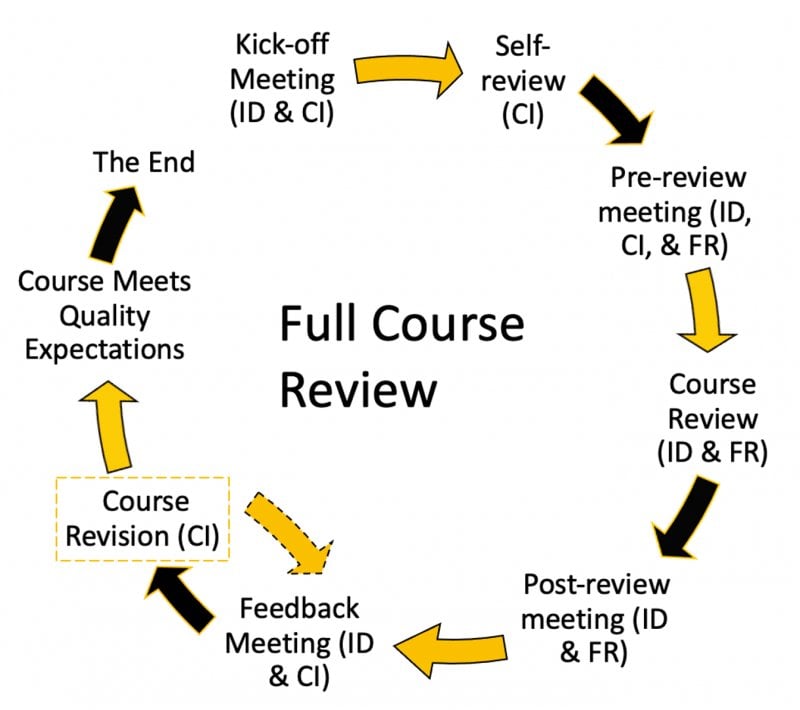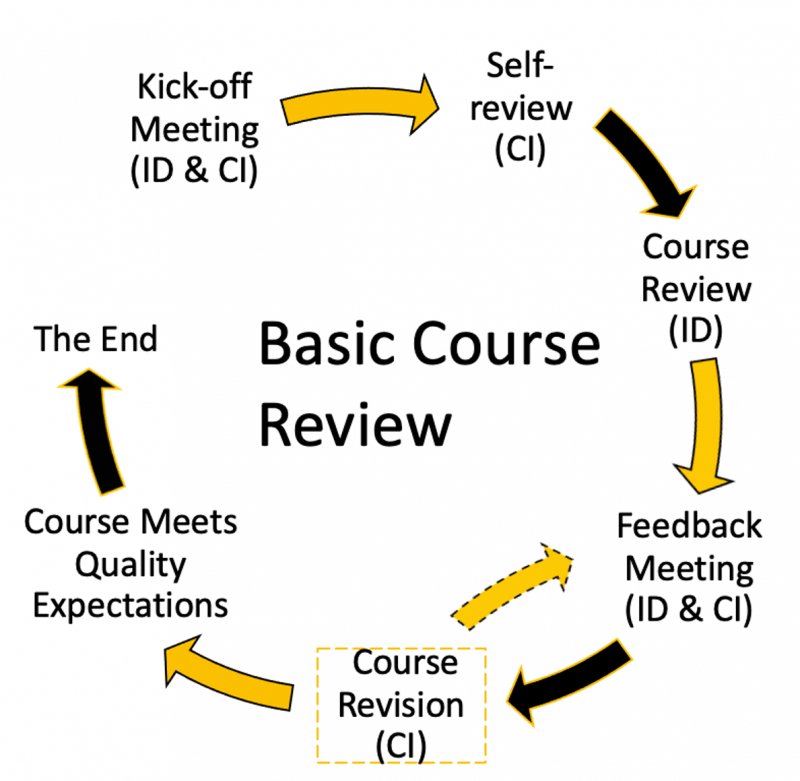Purpose
To ensure the quality of online courses, Michigan Tech has established a Senate policy which requires all online courses to be peer reviewed. Please refer to the links below for more details on the senate policy.
- Senate Policy 116.1
- Senate Procedure 116.1.1
- Online Course Resources from provost’s office
Two -Tier Course Review Process
For online courses, a two-tier course review system has been established — a full course review and a basic course review. Based on enrollment and the course offering frequency, each online course will be assigned to one level of the course review by the provost’s office. The provost’s office will also email the course instructor, the department chair, and the CTL instructional design team to initiate the course review process.
Full Course Review
Full Course Review Rubric
The Quality Matters (QM) Higher Education Rubric (7th edition) will be used to evaluate the quality of online courses during the full course review process. The QM course review management system will be used for the full course review.
Full Course Reviewers
Two reviewers will be involved in the course review process: an instructional designer (ID) from CTL and a faculty reviewer (FR). The instructional designer will review, manage, and support the course review process. A faculty reviewer who is familiar with the subject matter of the course will also review the course and provide feedback.
Full Course Review Process
Once the CTL receives an email from the provost’s office indicating a course should be reviewed, an instructional designer will be assigned to the course and the course review process will begin. Review the full course review steps and flow diagram below:
-
The ID will host a kick-off meeting with the course instructor (CI) to introduce the course review process, QM course review management system, timeline, and responsibilities of each role.
-
The CI completes a self-review of the course using the QM higher education rubric (7th edition) and makes any necessary revisions.
-
Once the course is ready, the ID will host a pre-review meeting with the CI and FR to introduce the course review process, timeline, responsibilities of FR, reviewer worksheet, and information about “How to Write Helpful Recommendations” from QM.
- The ID and FR will review the course using the QM higher education rubric (7th edition) and take notes of suggestions and feedback
- Once the review is complete, the ID will host a post-review meeting with the FR to review and discuss the review results.
- The ID will host a feedback meeting with the CI to discuss the review results and give suggestions for improvement.
- If the review results show that the course meets the quality expectations, then the course review ends; if the review results show that the course does not meet the quality expectations, then the CI needs to revise the course.
- The ID checks the revisions. If the revisions the CI made meet the quality expectations, then the course review ends. If not, repeat steps six to eight until the course meets the quality expectations.

Basic Course Review
Basic Course Review Rubric
The CTL has developed basic review standards for courses that have been identified as needing a basic online course review. These standards align with the 7th edition Quality Matters (QM) Higher Education Rubric, but incorporate less strict requirements. The QM course review management system will not be used for the basic course review.
Basic Course Reviewer
An instructional designer from the CTL will serve as the course reviewer to review, manage, and support the basic course review process. No faculty reviewers will be required in the basic course review process.
Basic Course Review Process
Once the CTL receives an email from the provost’s office indicating the course should
be reviewed, an instructional designer (ID) from CTL will be assigned to the course,
and the course review process will begin. Review the basic course review steps and
flow diagram below:
- The ID will host a kick-off meeting with the course instructor (CI) to introduce the course review process, timeline, and responsibilities of each role.
- The CI completes a self-review of the course using the basic course review rubric and makes any necessary revisions.
-
Once the course is ready, the ID will review the course using the basic course review rubric.
-
Once the review is done, the ID will host a feedback meeting with the CI to discuss the review results and provide suggestions for improvement.
- If the review results show that the course meets the quality expectations, then the course review ends; if the review results show that the course does not meet the quality expectations, then the CI the feedback and suggestions to revise the course.
-
The ID will review the course revisions. If the revisions implemented by the CI achieve course quality expectations, then the course review ends. If not, the CI will repeat steps four to six until the course meets the quality expectations.
